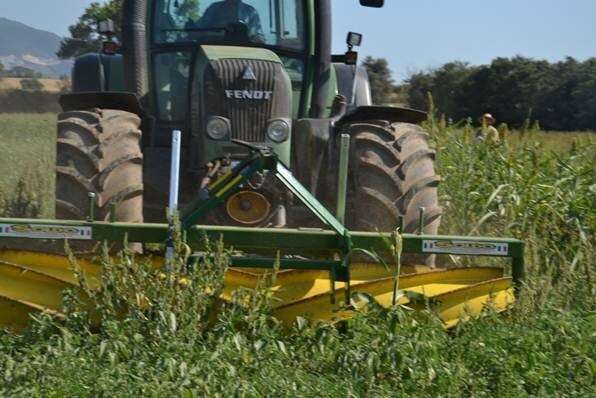How to improve crop management in organic horticulture

Sowing crops with agroeconomical services, that is, with benefits for the global ecosystem in crop practices is an efficient strategy for improving environmental sustainability. Now, an international study reveals that the uses of the technique called roller crimper —creating a layer of plant waste in the crop surface without perturbing the soil— contributes to improve the performance of the agroecological crops, reduces the environmental impact and protects the biodiversity in the environment.
The article, published in the Journal of Applied Ecology, is coordinated by Professor Francesc Xavier Sans, head of the Research Group of Ecology of Agricultural Systems, member of the Faculty of Biology and director of the Biodiversity Research Institute (IRBio) of the University of Barcelona. This multidisciplinary study analyzes for the first time the agronomic, ecologic and environmental impact of the introduction of technological innovations in the management of the European ecological crop systems, in order to deal with the environmental and agronomic challenges of crop activities and offer innovative solutions to the agricultural sector as well as to managers and policy-makers.
The study, whose first author if the expert David Navarro-Miró (UB-IRBio), goes over the results obtained by fifteen research groups in eleven experiments conducted in ecological crop systems as part of the SoilVeg project, funded by the EU ERA-Net CORE Organic Plus program. Among the collaborators in this meta-analysis study is the lecturer José Manuel Blanco-Moreno (UB-IRBio), who took part in the management of the database and the statistical analysis.
Ecological agriculture in the European context
The current agro-feeding model is based on the intensive agricultural and farming production to respond to the growing demand of the world population. This resource-exploitation model has progressively degraded the natural environment, which caused the loss of biodiversity, habitat deterioration, soil erosion and pollution by fertilizers and agricultural chemicals in rivers and ground waters.
To tackle this global problem, the European Commission launched the Biodiversity strategy for 2030, the European Green Deal and the Bioeconomy strategy, a model based on the use of renewable biological resources. This strategy puts emphasis on the urgent need for implementing actions and strategies based on nature and ecosystem services to respond to the challenge of developing sustainable production models.
"The gradual increase of the managed agricultural surface according to the principles of ecological agriculture is a strategy aiming to improve the quality of soils and reducing the environmental impact of the agricultural production. However, the growing organic market has created a new profitable niche, which attracts the attention of actors who follow the current conventional agri-food model," notes Francesc Xavier Sans, from the Department of Evolutionary Biology, Ecology and Environmental Sciences of the UB.
"The standardization of the ecologic agricultural systems, which is based on the intensive use of energy, high perturbation of the soil and the application of external products in farms for the fertilization and protection of crops, has led to the intensification and specialization of ecological production. Therefore, several studies have questioned its environmental benefits and its agronomic viability."
Agronomic and environmental challenges in ecological agriculture
Horticultural crops are those that require a higher consumption of energy, agricultural chemicals and irrigation needs to guarantee its economic performance. This excessively intensive management model has caused several environmental problems due to the high use of non-renewable resources and the leaching of nutrients, as well as harmful effects on the health due to the presence of pesticide remains.
The study, by the Research Group of Ecology of Agricultural Systems, analyzes the benefits of the application of the roller crimper technique in the ecological agriculture, which creates a thick layer of plant residues (mulch) connected to the soil via the roots.
"Compared to other strategies—for instance, the use of green manures—the roller crimper contributes to improving crop management, less weed abundance, reducing the environmental impact, increase of potentially recyclable energy, and conserving biodiversity, higher activity density of beneficial taxa to regulate pests, such as carabids and staphylinidae," says David Navarro-Miró, member of the mentioned research group.
It is essential to redesign the ecological horticulture systems and assess their sustainability considering the agronomic, environmental and ecological indicators simultaneously, as noted by the authors. This would be the only way to improve its functioning and reduce their environmental and social impacts.
"For instance, the dependence of the plowing to manage weed—the main factor that limits the production in ecological horticulture systems—affects negatively the sustainability of crops. Plowing has a high consumption of fuel, it favors the degradation of organic matter and has a direct negative impact on the organisms of soil which can have consequences on the biological control of plagues and diseases. However, the adoption of a less intensive soil management can reduce the performance and quality of the trade crops," says José Manuel Blanco-Moreno.
Promoting changes in the management of the European agricultural systems
Bringing new agricultural practices is a decisive factor in this process for redesigning the agricultural systems. Therefore, in order to ease the decision-making, the agricultural sector needs to have a good scientific knowledge on the agroeconomic, ecological and environmental implications. In this context, the multidisciplinary research study coordinated at a European level is the first step to promote changes in the management of the agricultural systems.
In this scenario to create new knowledge, "there is room for improving the efficiency of the roller crimper strategy from the agroeconomic and environmental perspective, as well as providing a broader acceptation of this technique from the agricultural sector," concludes the team of the Research Group of Ecology of Agricultural Systems.
More information: David Navarro‐Miró et al, The concurrent assessment of agronomic, ecological and environmental variables enables better choice of agroecological service crop termination management, Journal of Applied Ecology (2022). DOI: 10.1111/1365-2664.14112
Journal information: Journal of Applied Ecology
Provided by University of Barcelona




















